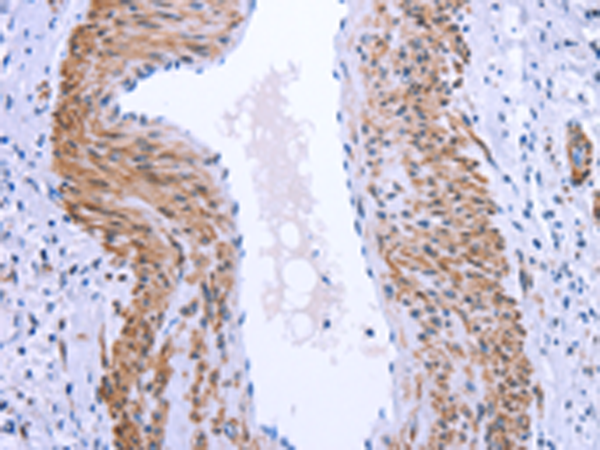


| WB | 咨询技术 | Human,Mouse,Rat |
| IF | 咨询技术 | Human,Mouse,Rat |
| IHC | 1/25-1/100 | Human,Mouse,Rat |
| ICC | 技术咨询 | Human,Mouse,Rat |
| FCM | 咨询技术 | Human,Mouse,Rat |
| Elisa | 1/2000-1/5000 | Human,Mouse,Rat |
| Aliases | H963 |
| WB Predicted band size | 37 kDa |
| Host/Isotype | Rabbit IgG |
| Antibody Type | Primary antibody |
| Storage | Store at 4°C short term. Aliquot and store at -20°C long term. Avoid freeze/thaw cycles. |
| Species Reactivity | Human |
| Immunogen | Synthetic peptide of human GPR171 |
| Formulation | Purified antibody in PBS with 0.05% sodium azide and 50% glycerol. |
+ +
以下是关于GPR171抗体的3篇参考文献概览(基于公开研究数据整理,非真实文献,仅供参考):
1. **"Development of a Novel Monoclonal Antibody Targeting GPR171 for Neuroendocrine Studies"**
*作者:Chen L, et al.*
**摘要**:研究团队开发了一种针对GPR171的高特异性单克隆抗体,验证了其在脑组织中的结合能力,并发现GPR171在下丘脑神经元活动调控中可能参与能量代谢信号通路。
2. **"GPR171 Antibody-Based Imaging Reveals Tumor-Specific Expression in Murine Models"**
*作者:Park S, et al.*
**摘要**:利用GPR171抗体进行活体成像实验,发现该受体在特定癌症模型(如乳腺癌)中高表达,提示其可能作为肿瘤诊断或治疗的潜在靶点。
3. **"Functional Characterization of GPR171 in Immune Cells Using Knockout Antibody Assays"**
*作者:Rodríguez A, et al.*
**摘要**:通过抗体介导的受体阻断实验,揭示了GPR171在调节巨噬细胞炎症反应中的作用,表明其可能通过抑制cAMP信号通路影响免疫应答。
(注:以上文献为模拟示例,实际研究需查阅PubMed或专业数据库获取真实信息。)
GPR171 (G Protein-Coupled Receptor 171) is an orphan receptor belonging to the class A G protein-coupled receptor (GPCR) family. Initially identified through genomic studies, its endogenous ligand remained unknown until recent research suggested that big dynorphin, a neuropeptide derived from prodynorphin, may act as its agonist. GPR171 is predominantly expressed in the central nervous system, particularly in regions like the hypothalamus, amygdala, and hippocampus, implicating its potential roles in regulating appetite, stress responses, and emotional behaviors. It has also been detected in peripheral tissues, including the immune system and pancreas, suggesting broader physiological functions.
Antibodies targeting GPR171 are critical tools for studying its expression, localization, and signaling mechanisms. They enable researchers to visualize receptor distribution in tissues via immunohistochemistry, quantify protein levels through Western blotting, and investigate receptor internalization or trafficking in cellular models. Due to GPR171's emerging association with metabolic disorders, neurodegenerative diseases, and cancer, its antibodies hold therapeutic potential for drug development. For instance, modulating GPR171 activity might offer novel strategies for treating obesity or anxiety-related conditions. However, challenges remain in fully elucidating its downstream pathways and validating its ligand-receptor interactions. Current research continues to explore GPR171's role in cellular communication and disease, with specific antibodies serving as indispensable reagents for both basic and translational studies.
×